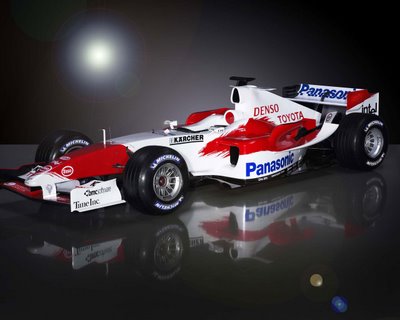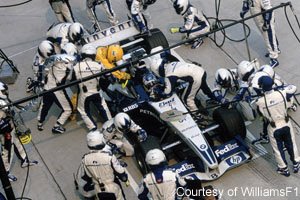
I spent the end of last week in Indianapolis at the Formula One race, something I've managed to do for five of the seven years this race has been run at this location. I'm fortunate in that the race is both right along my commuting path from WI to KY, and in that my crash pad in Louisville is a comfortable two hour drive from the race track, which saves me the money otherwise spent on hotels and lets me stay at home, more or less.
I have introduced a few friends to this race series over my years as a fan. F1 is, hands-down, the most popular single motor racing series in the world, with a worldwide audience in the millions, but it has strangely failed to gain much of a foothold in the US. This particular race at Indianapolis is one of the more heavily-attended races on the F1 calendar, but looked at from the perspective of the US's population it's hardly a blip on the US racing radar; the other two races held at Indy--the IRL's Indianapolis 500, and the Brickyard 400 NASCAR race--are both better attended.
I guess the devotees of any sport, or even any sect within a particular sporting community, will have their specific and militantly-held areas of enthusiasm, but this relative unpopularity of F1 here is a mystery to me (as is, I'm sure, my complete disinterest in NASCAR to any fan of that series, though I'd be happy to explain myself to those who will sit still for it). These cars are simply the fastest, quickest (that is, most agile in gaining and losing speed), most sophisticated four-wheeled machinery on the planet, and when applied to the easily comprehensible business of getting most rapidly around a racetrack it's a great combination. The rest of it--the internationalism, the derring-do of the drivers, the labyrinthine political intrigue--can be taken or left, I imagine; but as a racing series it's a fantastic show.
The most striking aspect of this whole circus is the money. I think there are few places where regular folks might go and see the products of a fiercely competitive annual expenditure of $200-$400 MILLION. Per team. That's what it takes to field a reasonably competitive team of two cars for a single season. The resources devoted to ongoing development of the most minute aspects of the car and the resulting level of sophistication have few parallels in any other mainstream industry, and again, is something most of us in this country will never have seen. The top teams have two full-scale wind tunnels in use 24/7. Engineers on staff number in the hundreds, specialized into units focused on different aspects: things like aerodynamics, engine, transmission, composites, chassis, tire integration. Each team. Many teams run whole second teams in a testing capacity, year-round, and a couple teams--Red Bull and now Honda--are running actual second race squads--sub-brands, if you will--ostensibly to double their data and, not incidentally, their advertising opportunities.
This year the regulations specify that engines are to be V-8s (they've been V-10s for the last decade or so) of no more than 2.4 liters in capacity. That's not a very big engine--the size of a 4-cylinder engine of 150 hp or so in an Accord or a Camry. The engines are naturally-aspirated (no turbocharging or supercharging) and burn the same fuel we buy at the gas station. But that 2.4 liter V-8 engine, without any smoke and mirrors or other trickery, produces over 700 horsepower, in part by spinning at 19,000 rpms (a couple manufacturers have run over 20,000 rpms in testing). If you can't make power by bigger explosions, then you just make more of the little ones. LOTS more. This all produces a sound like you can't quite imagine. I've argued to the few people I've helped introduce to the sport that it's the SOUND that sucks you in: F1 is a much louder and more visceral experience than what TV leads us to believe. And again, not loud for spectacle's sake; but this is what maximum power production yields.

Another example of technology. Brake discs are all made of carbon fiber (actually, much of the car is made of this--chassis, wings, suspension, some transmission pieces, etc.), and it takes six months to produce a single set and costs untold thousands (I think I've heard the figure of $60,000 per set of four, but that's just a stab on my part). They will last a single race weekend with luck. Their advantage over steel brakes is not power (you can lock the tires with steel brakes just fine) but in weight savings: the carbon discs save something like two pounds over steel ones--a huge number when many similar advances yield grams. And that weight savings is worth the many thousands of dollars. (And actually, truth be told, it's not even a matter of weight savings so much as control over weight distribution: the cars are always under their minimum allowed weight, so that ballast must be added to get the car up to legal weight. But this way, the engineers get to pick precisely where that weight goes.)
These details get repeated over and over for each system on the car. The cars are able to generate over 2Gs of acceleration force, 4 Gs of cornering force, and over 5Gs of deceleration under braking (because of the aerodynamic wings pressing the car into the road and maximizing the tires' grip). A modern F1 car can accelerate from a dead stop to 100 mph and back to zero in under seven seconds! One of the corners at Indy sees the cars approach at 205 mph and slow to 60 mph in just 75 yards for the 90° turn. When you first witness it, it seems to defy everything you understand about the physical world.
Anyway, it's too easy to go on and on. The end result of it all is a collection of 22 almost impossibly fast road cars fighting it out for this one race and its share of the season's championship points for manufacturer's and driver's titles. This year's race was action-packed, with only 9 cars finishing.
Highly recommended!
7 comments:
I suspect that the lack of interest in the US stems from the apparent elitism of F1. NASCAR has the appearance of something that any good-old-boy could do - even though those teams operate on pretty big budgets too. I think that CART and IRL suffer a bit from the same stigma.
It also may not hurt that the NASCAR guys run a race just about every week, so there is no need to wait for your fun. Plus, with more races it is more likely that you'll have a race nearby to go see.
On top of all that, what self-respecting American can get excited about a sport that is dominated by foreigners?
I had no idea the engines were so small. That is impressive.
My lack of enthusiasm, I think, is just the repetativeness. Not just that they are going round and round, week in and week out, bu thtat the same people are always at the head of the pack, the same head pack is always moving forward, and the same stories: the rivalries, the technology, the bootstrap stories, play over and over.
Plus, no one is on steroids. Eesh.
The business of foreigners in F1 is actually, here, not something positive (indeed, I've heard the same criticism of CART, that their driver pool has too many foreigners, too few Americans), whereas elsewhere in the world it's seen as a feather in F1's cap. The company Red Bull has done an exhaustive young American driver search to find someone that Americans can hang onto (apparently even the French Canadian Jacques Villeneuve is just not to our tastes in spite of having won the Indy 500), and the aptly-named Scott Speed of California was the winner. He's driving this year for Red Bull's B-squad (Scuderia Toro Rosso) but hasn't done too much thus far.
I think you're right, Jeffy, about the perceived elitism, though I think the converse of that--Nascar's good ol' boy thing--is cynical manipulation of a TV-watching audience. That, plus the idea that "I can drive a Dodge Charger just like my buddy X does!" which is marketing hooey: the cars have absolutely nothing in common. It's all spin.
I agree, Joshua, that there's a certain level of predictability to the whole circus; and I think the outcomes pretty closely reflect the operating budgets. But what is fascinating over the years is HOW things move forward. The slow teams of today are still faster than the fast teams of three years ago, and the development and adoption of new technologies is fascinating (if you're into that sort of thing).
My biggest criticism of Nascar (apart from the image hooey) is the fact that they run only ovals. Ovals are dull. Road racing series require the use of brakes and gearboxes and precise cornering lines, and each of these things requires frenetic engineering of advancing technology.
Ferrari was at the head for five or six year (though the details of how they managed to achieve this are quite fascinating to study), but now they're trailing Renault and, if Mercedes could make a reliable engine, McLaren. The same big teams, but winning is everything, and Ferrari in second or third is a loss to them (and to their fans).
To clarify: I think the internationalism of F1 is all to the good. But in the US it's seen as a detriment. In case that wasn't clear.
I just told my oldest the 22 cars started, only 9 finished thing. He's way jealous of you.
If they had oil slicks and missiles, I would watch.
Actually, the entire car is a missle of sorts! And when only 9 of the original 22 starting cars finish the race, you can bet there's an oil slick (with razor-sharp shards of carbon fiber mixed in) somewhere!
Post a Comment